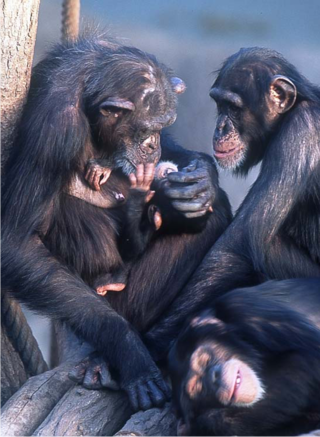Relationships
The Favorite Animals of Comparative Psychologists
Why some animals seem to get all the attention.
Posted July 21, 2022 Reviewed by Abigail Fagan
Key points
- Comparative psychologists compare the cognitive abilities of various animal species with those of humans.
- Social animals are especially interesting to comparative psychologists, as they have to deal flexibly with social situations.
- For different reasons primates, dogs and crows are especially interesting to comparative psychologists.
As the name suggests, the main concern of comparative psychology is comparing the cognitive abilities of various animal species with those of humans. But how do we choose our subjects? Why is it that in this post I'll talk more about primates, dogs and crows than, say, bears, leopards and turtles?
Cognition is adaptive
The reason we choose certain animals to study is not that we love them, although often we do. There are of course scientific reasons that make these species such great subjects. We choose our subjects based on cognitive skills, which biologists going back to Darwin knew to be adaptations. This implies that these skills are subject to the laws of evolution, with certain selection pressures favoring the development of certain abilities (Bräuer et al., 2020). This evolutionary adaptive response applies to the ability to fly as well as to the cognitive ability to plan for the future.

Because social situations place pressure on cognitive skills, social animals are especially interesting for comparative psychologists. Imagine animals living in a complex social group with members having various different relationships. Members of such a group have to know who is related to whom in order to form alliances and navigate conflicts. One might be able to push around low ranking members of the group, but only if they know whom the lower-ranking member is related to. It would be advantageous to make sure that the alpha female is not around if you want to tease her daughter.
In complex social environments, natural selection favors those individuals with the ability to deal flexibly with social situations. And reacting flexibly is a typical aspect of cognition, indeed. That is why studies with loner species, such as bears and leopards, are less common than studies of social animals. Sociality has led to the evolution of cognitive traits that hold great insights for comparative psychologists.
Apes, dogs and crows
And of course, we like to test primates, in particular great apes. As our closest living relatives, they are not so different from us, including in their cognitive skills. Chimpanzees can produce tools, understand causal relationships, plan for the future, do statistics and assess the intentions and perspectives of others.
Dogs are another favorite subject of comparative psychologists. This is of course not because dogs are closely related to us. It is because of the ecological niche they have been living in for about 30,000 years. To survive in this niche, that is, in the human environment, dogs have evolved some unique skills. Dogs for example outperform apes in some tasks, especially when it comes to communication with humans.
In biology, the process that explains these abilities in dogs is called convergent evolution: analogous behaviors and skills have evolved independently in dogs and in humans because both were faced with similar selection pressures. This may sound like a difficult concept, but it is very similar to the development of wings. Birds and insects have developed wings to conquer the niche of air space. However, even though the function of wings is the same in birds and insects, their origins and structures are different. Bird wings evolved from the remodeling of their forelimbs (Prum, 1999). Insect wings, on the other hand, evolved from protrusions of the skin (La Greca, 1980). Different adaptations lead to the same unique ability: flight.
Similarly, humans and dogs also live in the same ecological niche and have evolved similar skills in some areas. But this does not mean that dogs have the minds of humans, like some dog owners assume. Studies have shown that sometimes it only seems like dogs and humans behave similarly — in fact, dogs sometimes do the same things for different reasons.
Another species that comparative psychologists are really interested in are crows, as I described in my last post. Crows are obviously not closely related to us, and they have not lived with us for the last 30,000 years. But another common factor connects them to dogs, apes and us: They live in complex social groups. In addition, it seems that at least some of them live in harsh environments where it is difficult for them to get access to food, forcing them to develop some cognitive skills that would help them survive.
Crows also provide another practical example for convergent evolution. In humans we are just starting to understand how the brain works. But one thing is quite certain — that our complex cognitive abilities have their origin in the neocortex, an enormous region in the human brain. So, we would assume that this is also the case for animals with sophisticated cognitive skills. But crows simply do not have a neocortex — thus they have evolved what a famous paper described as “cognition without cortex” (Güntürkün & Bugnyar, 2016).
Once again, birds did it their way. They developed wings — but different ones than insects. And they developed cognitive skills — but using a different brain structure than humans.
So although cognitive psychologists do love the animals we study, we don’t choose subjects for their “loveable-ness.” We choose them based on the cognitive traits they exhibit, whether they were developed through millennia of cooperating with humans, a genetic history we share, or from the pressures of social interaction.
References
Bräuer, J., Hanus, D., Pika, S., Gray, R., & Uomini, N. (2020). Old and New Approaches to Animal Cognition: There Is Not "One Cognition". J Intell, 8(3).
Güntürkün, O., & Bugnyar, T. (2016). Cognition without cortex. Trends in Cognitive Sciences, 20(4), 291-303.
La Greca, M. (1980). Origin and evolution of wings and flight in insects. Bolletino di zoologia, 47(sup1), 65-82.
Prum, R. O. (1999). Development and evolutionary origin of feathers. Journal of Experimental Zoology, 285(4), 291-306.




